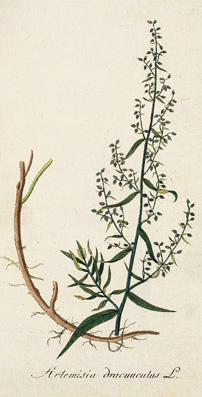Tasteful Tarragon
By Audrey Stallsmith

"I believe that if ever I had to practice cannibalism, I might manage if there were enough tarragon around."
James Beard
French tarragon is the “good” tarragon and Russian tarragon the “bad” one, but French tarragon probably came from Russia originally. Confused yet?
You can differentiate the two by their Latin names, but you’ll have to concentrate hard to do so. French tarragon, called that because it is the type used in French cooking, is Artemeisa dracunculus var. sativa. It boasts a pleasant anise flavor but, because its tiny greenish white flowers usually are sterile and make no seeds, it must be propagated by cuttings or divisions.
So, if you see seeds of tarragon offered for sale, they probably are from the more vigorous Russian variety, Artemisia dracunculoides, which--despite its similar name--reportedly has an inferior flavor. But the French type really originated in parts of Russia and western Asia just as its larger, coarser, and less savory brother did. Both are related to wormwood, with all the artemisias being named for Artemis, Greek goddess of the hunt.
"Tarragon" may have derived from people mangling the pronunciation of the the Arabic tarkhun or French estragon (“little dragon”). The species names beginning with “drac” also mean “dragon.”
As if two national tarragons weren't enough, there also is a Mexican variety, which actually is a type of marigold, Tagetes lucida. Since it comes from an entirely different family of plants and is hardy only to zone 8, we will stick to our doughtier dragons at present.
We can assume that the French one now is a tame dragon, since its sativa means “cultivated.” Not being a very cultivated type myself, I probably wouldn’t be able to tell the difference between French and Russian tarragon if I hadn't had it explained to me.
I used to like to grab fresh herbs to chop into my scrambled eggs in the morning, though, and French tarragon was one of my favorites. Although many of my herbs since have died of longing for sunny skies and dry feet, I’m hoping to at least be able to grow a few in containers.
French tarragon is a hardy plant, but it needs very well drained soil to survive our winters—of which we have had none in recent years. No well-drained soil, that is, though some could argue that we had very little actual winter this year either!
So, last summer, I set a purchased tarragon plant in a grow bag with several chive plants and a strawberry plant and positioned the bag in a convenient place beside our front porch steps. I am happy to see that all survived our wimpy winter and now are making new growth. With any luck, maybe I can run out and grab fresh tarragon or chives for the aforementioned eggs and fresh strawberries to top my breakfast cereal.
Often used to flavor vinegars, tarragon goes well with chicken and fish too. It reportedly also improves your appetite, digestion, and sleep and can reduce blood sugar and water retention, as well as killing bacteria. Although once used as a breath freshener, it will numb your mouth if you chew it, which may or may not be a good thing.
Folklore holds that the plant also will cure bites of venomous creatures such as asps and mad dogs, but I wouldn’t put much faith in that! I’ve also heard of a carbonated beverage called Tarkhun, which is flavored with tarragon and woodruff.
I couldn’t find a good explanation for why the former is called "the dragon herb," except for the possibility that the coils of its root reminded people of the coils of the legendary creature. And that idea seems to be stretching the bounds of probability.
Nor could I discover why tarragon stands for “lasting interest” in the Language of Flowers, when it is one of the least lasting herbs out there—with everyone agreeing that the fresh leaves are much superior to the dried. But tarragon probably would say that a dragon doesn’t need to explain itself. It just lets its flame or its flavor do the talking for it.
The Artemesia dracunculus image is by J. S. Kerner from Abbildungen aller ökonomischen Pflanzen ("Images of All Economic Plants"), courtesy of plantillustrations.org..








